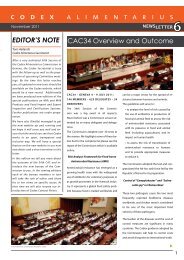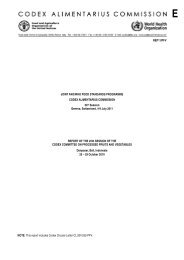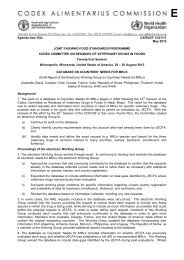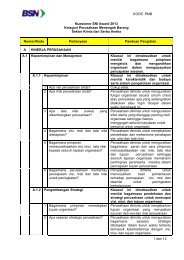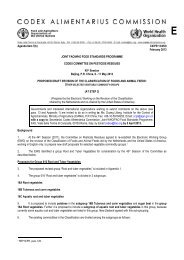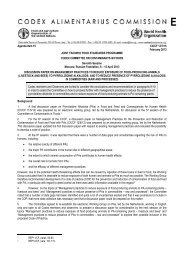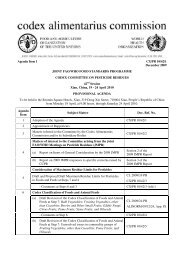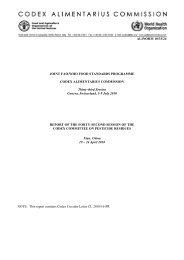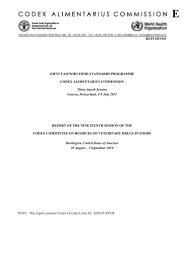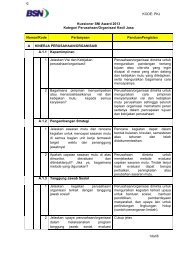Agenda Item 16 CX/CF 13/7/16 February 2013 JOINT FAO ... - FAO.org
Agenda Item 16 CX/CF 13/7/16 February 2013 JOINT FAO ... - FAO.org
Agenda Item 16 CX/CF 13/7/16 February 2013 JOINT FAO ... - FAO.org
- No tags were found...
Create successful ePaper yourself
Turn your PDF publications into a flip-book with our unique Google optimized e-Paper software.
E<strong>Agenda</strong> <strong>Item</strong> <strong>16</strong> <strong>CX</strong>/<strong>CF</strong> <strong>13</strong>/7/<strong>16</strong><strong>February</strong> 20<strong>13</strong>BACKGROUND<strong>JOINT</strong> <strong>FAO</strong>/WHO FOOD STANDARDS PROGRAMMECODEX COMMITTEE ON CONTAMINANTS IN FOODSSeventh SessionMoscow, Russian Federation, 8 – 12 April 20<strong>13</strong>DISCUSSION PAPER ON THE REVIEW OF THE GUIDELINE LEVELSFOR METHYLMERCURY IN FISH AND PREDATORY FISHCodex members and Observers are invited to consider the discussion (paragraphs 74-83) and in particular therecommendations (paragraphs 81-83) in order to assist the Committee on how to proceed further with the reviewof the Guideline Levels for Methylmercury in Fish and Predatory Fish in the General Standard for Contaminantsand Toxins in Food and Feed (GSCTFF).1. The 38 th session of the Committee on Food Additives and Contaminants (C<strong>CF</strong>AC) 1 requested the 29 th session of the CodexAlimentarius Commission (CAC) 2 in 2006 to seek scientific advice from the Food and Agriculture Organization of the United Nations(<strong>FAO</strong>) and the World Health Organization (WHO) on the risks and benefits of fish consumption (1): specifically, advice on thenutritional health benefits compared to the risks of consuming fish that may be contaminated with methylmercury and dioxins 3 . Thereport from the Joint <strong>FAO</strong>/WHO Expert Consultation on the Risks and Benefits of Fish Consumption was published in 2011 and isavailable at the following URL: http://www.who.int/foodsafety/chem/meetings/jan2010/en/index.html.2. As a follow up to the Expert Consultation, the 6 th session of the Committee on Contaminants in Food (CC<strong>CF</strong>) agreed to thedevelopment of a discussion paper on the review of the guideline levels (GLs) for methylmercury in fish and predatory fish throughan electronic Working Group led by Norway and co-chaired by Japan for consideration and discussion at the 7 th session of the CC<strong>CF</strong>in 20<strong>13</strong> with a view to identifying possible actions or new work on this issue. 43. The electronic Working Group addressed the following issues in the discussion paper for consideration at the 7 th CC<strong>CF</strong> Session:Whether a review of the guideline levels for methylmercury in fish and predatory fish is required;Appropriate analytical methods for checking compliance with Codex GLs (GLs for methylmercury vs for total mercury);Definition of predatory fish;What other risk management options have been implemented by Codex members to address the risk and benefits fromfish consumption (including regulatory and non-regulatory options).4. The electronic Working Group members have been the following: Argentina, Australia, Brazil, Canada, China, Colombia, IA<strong>CF</strong>O,Japan, Norway, Oman, Spain, United Kingdom and the United States of America (See Appendix).INTRODUCTION5. Fish is an integral component of a balanced diet, providing a healthy source of dietary protein and nutrients such as LCn3PUFAs.There is evidence of beneficial effects of fish consumption. In contrast, fish can also contribute significantly to the dietary exposure tocertain chemical contaminants under some circumstances. The health benefits and risks are likely to vary according to the fishspecies, fish size, harvesting, and cultivation practices, as well as the amount consumed and the way in which it is served. There area number of potential contaminants of concern in fish; methylmercury is the subject of this discussion paper.1ALINORM 06/29/12, paras. 191-193.2ALINORM 06/29/41, para. 195.3Dioxins include polychlorinated dibenzo-p-dioxins [PCDDs] and polychlorinated dibenzofurans [PCDFs] as well as dioxin-like polychlorinatedbiphenyls [PCBs]).4REP12/<strong>CF</strong>, paras. 45, 174.
<strong>CX</strong>/<strong>CF</strong> <strong>13</strong>/7/<strong>16</strong> 26. In January 2010, the <strong>FAO</strong> and WHO held an Expert Consultation on the Risks and Benefits of Fish Consumption on thebackground of growing public concern regarding the presence of specific chemical contaminants in fish, while at the same timemultiple nutritional benefits of including fish in the diet have become increasingly apparent. This situation has led to confusion andquestions about how much fish should be consumed, and by what populations, in order to minimize the health risks of contaminantsthat may be present in fish, yet maximize the health benefits of fish consumption. National authorities have been faced with thechallenge of communicating the risks and benefits of fish to consumers and also with questions on whether maximum levels are theappropriate risk management tools for specific chemical contaminants in fish and other foods.7. Seventeen experts in nutrition, toxicology, epidemiology, dietary exposure and risk-benefit assessment attended the ExpertConsultation. Their tasks were to review data on levels of nutrients (long-chain omega-3 fatty acids) and specific chemicalcontaminants (methylmercury and dioxins) in a range of fish species, as well as recent scientific literature covering the risks andbenefits of fish consumption. The review was used to consider risk-benefit assessments for specific end-points.8. Based on the strength of the evidence, the Expert Consultation examined the benefits of fish consumption for optimalneurodevelopment and prevention of cardiovascular disease. The Expert Consultation also examined the risks to fish consumers ofingesting methylmercury and dioxins.9. Codex GLs for methylmercury are set at 1 mg/kg for predatory fish and 0.5 mg/kg for all other fish. In view of therecommendations from the Expert Consultation, it seems necessary to review these levels and other risk management measuresand options available to the Codex Alimentarius.TOXICOLOGY METHYLMERCURY10. Methylmercury is toxic, particularly to the nervous system. The Joint <strong>FAO</strong>/WHO Committee on Food Additives (JE<strong>CF</strong>A) (2)concluded that methylmercury can induce toxic effects in several <strong>org</strong>an systems and that neurotoxicity is the most sensitive endpoint.The developing brain is thought to be the most sensitive target <strong>org</strong>an. High methylmercury intake by pregnant women has beenlinked to adverse effects in neurological developmental in children. In utero exposure is believed to be the critical period formethylmercury neurodevelopmental toxicity. However, the duration of increased susceptibility may extend into postnataldevelopment (3), for example during the first few years of life when the brain is developing and growing rapidly.11. The 67 th JE<strong>CF</strong>A meeting in 2006 confirmed the provisional tolerable weekly intake (PTWI) of 1.6 μg/kg bw, set in 2003, based onthe most sensitive toxicological end-point (developmental neurotoxicity) in the most susceptible species (humans) (4). However, theCommittee noted that life-stages other than the embryo and fetus may be less sensitive to the adverse effects of methylmercury.12. The Joint <strong>FAO</strong>/WHO Expert Consultation on the risks and benefits of fish consumption concluded that:There is convincing evidence of adverse neurological/neurodevelopmental outcomes in infants and young children associatedwith methylmercury exposure during fetal development due to maternal fish consumption during pregnancy;In addition, there is possible evidence for cardiovascular harm and for other adverse effects (e.g. immunological andreproductive effects) associated with methylmercury exposure.<strong>13</strong>. In addition to the JE<strong>CF</strong>A risk assessment, it is prudent also to consider the conclusions of relevant risk assessments conductedelsewhere. For example, a previous evaluation by the United States (US) National Research Council (NRC) in 2000 recommendedan upper intake limit of 0.7 μg/kg bw per week (5), which is lower than that of JE<strong>CF</strong>A.14. In the European Union, the European Food Safety Authority (EFSA) very recently (December 2012) considered newdevelopments regarding in<strong>org</strong>anic mercury and methylmercury toxicity and evaluated whether the JE<strong>CF</strong>A provisional tolerableweekly intakes for methylmercury of 1.6 µg/kg bw and of 4 µg/kg bw for in<strong>org</strong>anic mercury were still appropriate (6). In line withJE<strong>CF</strong>A, the CONTAM Panel established a tolerable weekly intake (TWI) for in<strong>org</strong>anic mercury of 4 µg/kg bw, expressed as mercury.For methylmercury, new developments in epidemiological studies from the Seychelles Child Developmental Study Nutrition Cohorthave indicated that n-3 long-chain polyunsaturated fatty acids in fish may counteract negative effects from methylmercury exposure.Together with the information that beneficial nutrients in fish may have confounded previous adverse outcomes in child cohortstudies from the Faroe Islands, the Panel established a TWI for methylmercury of 1.3 µg/kg bw, expressed as mercury.OCCURRENCE IN FISH15. Mercury occurs in the environment from natural sources, but also as a result of atmospheric deposition and pollution from man’sactivities. It accumulates in the aquatic food chain, including in fish and seafood, largely as methylmercury, which is the form oftoxicological concern. Methylmercury accumulates more in some types of fish than others. Key factors include the age, size, naturalenvironment and food sources. Fish that are more likely to accumulate higher levels of methylmercury are larger, longer living andpredatory species.
<strong>CX</strong>/<strong>CF</strong> <strong>13</strong>/7/<strong>16</strong> 3<strong>16</strong>. Examples of varieties found to contain high levels include shark (all species), swordfish/broadbill (Xiphias gladus), marlin(Makaira species, Tetrapturus species) and orange roughy (Hoplostethus atlanticus). Some species of tuna can also contain highlevels, such as big eye (Thunnus obesus), blue fin (Thunnus thynnus) and albacore tuna (Thunnus alalunga), although the averageconcentrations tend to be significantly lower than in the fish varieties listed above. Pike (Esox lucius), tilefish (Caulolatilus princes)and king mackerel (Scomberomous cavalla) from certain geographic locations can also contain relatively high levels of mercury.Mercury levels in canned tuna are often lower than in fresh tuna, largely due to the species or because smaller-sized fish are used.Skipjack tuna (Katsuwonus pelamis) is often canned and this variety tends to contain lower levels of mercury. However, species withhigher levels may also be canned, such as albacore tuna (Thunnus alalunga) known as canned ‘white’ tuna in some countriesincluding the US).17. Available data collected on mercury in fish are largely for total mercury rather than methylmercury. In most fish, methylmercurycan contribute more than 90% of the total mercury content; hence total mercury is generally a good indicator of methylmercuryexposure. In this paper unless otherwise defined a reference to mercury means total mercury.18. Using available data the Expert Consultation analyzed the composition of fish by developing a matrix comparing the levels of theLCn3PUFAs DHA and EPA with levels of total mercury.19. A significant correlation was found between the fat and EPA plus DHA concentrations.20. No significant correlation was found between the mercury content and content of another compound.21. A compiled data set created by the Expert Consultation in 2010, including the arithmetic mean content of total fat, EPA plus DHAand total mercury for 103 fish species, can be found in Appendix A of the report of the Expert Consultation 5 , while it should be notedthat, as the Expert Consultation pointed out, evaluation of the analytical quality of the samples is not possible in terms of analyticalmethods.EXPOSURE22. The 67 th JE<strong>CF</strong>A reported intake estimates close to and sometimes exceeding the PTWI of 1.6 μg/kg body weight (4). Valuesranged from 0.3 to 1.5 μg/kg body weight per week for the five regional GEMS/Food diets and from 0.1 to 2.0 μg/kg body weight perweek for numerous nationally-reported diets.23. In general, consumers who eat average amounts of varied fishery products are not likely to be exposed to unsafe levels ofmethylmercury. However, people who eat appreciably more than average amounts of certain types of fish are more likely to exceedthe recommended safety thresholds. Mercury toxicity in high consumers has been reported (7). In particular, based upon monitoringdata, population groups who frequently consume top predatory fish, such as shark, swordfish and some species of tuna, may have aconsiderably higher intake of methylmercury and exceed the PTWI.24. The Expert Consultation in its risk-benefit estimations uses one, two, three or seven servings of fish per week, typicalconcentrations of EPA plus DHA in different fish species and existing health based guideline levels for methylmercury, and assumesa serving size of 100 grams.25. The recent EFSA opinion concluded that the mean dietary exposure across age groups in Europe does not exceed the (new)TWI for methylmercury, with the exception of toddlers and other children in some surveys. The 95 th percentile dietary exposure isclose to or above the TWI for all age groups. High fish consumers, which might include pregnant women, may exceed the TWI by upto approximately six-fold. Unborn children constitute the most vulnerable group. Biomonitoring data from blood and hair indicate thatmethylmercury exposure is generally below the TWI in Europe, but higher levels are also observed. Exposure to methylmercuryabove the TWI is of concern. If measures to reduce methylmercury exposure are considered, the potential beneficial effects of fishconsumption should also be taken into account.26. In Australia, in 2011, the most recent dietary exposure estimates indicate that dietary exposures to methylmercury are below thePTWI of 1.6 μg/kg bw for all age groups at the 90 th percentile, and consequently within acceptable safety standards. The highestlevel of exposure was for 2-5 year olds at 80% of the PTWI, because of their high food consumption relative to body weight. Due tothe potential adverse effects of methylmercury on vulnerable population groups, such as pregnant women and young children,methylmercury will continue to be monitored in future studies.S eafoods were major sources of methylmercury exposure for all agegroups. Fish (uncrumbed/unbattered or canned) contributed 42-53% of total methylmercury exposure in children 12 years andyounger. Battered seafood contributed 41-44% of total methylmercury exposure for those aged <strong>13</strong> years and over.27. In Japan, the results of a total diet study for mercury under the normal dietary conditions showed an estimated average dailyintake of total mercury to be 8.17 µg/person from 1999 to 2008. This value is below the re-evaluated PTWI of JE<strong>CF</strong>A.28. In China, the results from 2007 total diet study for total mercury and methylmercury under the normal dietary conditions showedan estimated average of 0.068 µg/kg bw weekly and 0.041 µg/kg bw weekly, respectively, which are far below the correspondingprovisional tolerable weekly intake (PTWI).5 See http://www.who.int/foodsafety/chem/meetings/jan2010/en/index.html
<strong>CX</strong>/<strong>CF</strong> <strong>13</strong>/7/<strong>16</strong> 4ANALYTICAL METHODS29. The review of the GLs for methylmercury in fish should be based on scientifically sound occurrence data obtained usinganalytical methods validated in accordance with the internationally harmonized protocols 6 .30. In determining total mercury in fish, cold vapor flameless atomic absorption spectrophotometory (CV-AAS) methods and rapidmethods with direct mercury analyzers (an automated AAS which can determine total mercury in a test portion without any chemicalpretreatment) are usually used. In CV-AAS methods, all chemical forms of mercury are converted into mercury(II) ion by digestion ofa test portion (fish sample) with such mineral acid as nitric acid or sulfuric acid, and sometimes with additional oxidizing reagent.Mercury(II) ion is then reduced to elemental mercury by addition of reducing reagent such as tin(II) chloride. The elemental mercuryvapor at room temperature is introduced into an absorption cell and the absorption at 253.7 nm is measured for determination. InCodex, AOAC 977.15, CV-AAS method, has been endorsed as a Type III method for the determination of total mercury in fish andfishery products (CODEX STAN 234-1999). Other CV-AAS methods, such as AOAC 971.21, and AOAC 974.14, are available.40. Analytical methods for methylmercury in fish involve the extraction of methylmercury. Two types of extraction, hydrochloric acidleaching extraction and dithizone (diphenylthiocarbazone) extraction, have been widely used. In the hydrochloric acid leachingextraction, methylmercury in a test portion is extracted with <strong>org</strong>anic solvent such as benzene or toluene, followed by acidification toits halide, back-extraction into an aqueous solution of cysteine or glutathione, and re-extraction into an <strong>org</strong>anic solvent. If necessary,the <strong>org</strong>anic extract is dehydrated by addition of disodium sulfonate anhydride. In the dithizone extraction, a test portion isdecomposed under alkaline conditions and methylmercury is extracted with a dithizone-toluene solution as its dithizonate, followedby back-extraction into alkaline sodium sulfide and dithizone re-extraction. Recently, extraction without using benzene or toluene isalso used: methylmercury in a test portion is extracted with an aqueous solution of cysteine and HCl, or of cysteine, HCl andmercaptoethanol, without subsequent extraction with <strong>org</strong>anic solvents. The aqueous extract is then injected into a gaschromatograph (GC) or liquid chromatograph (LC) for separation and methylmercury is detected by electron capture detector (ECD),atomic fluorescence spectrophotometers (AFS), inductively coupled plasma-mass spectrometry (ICP-MS), or any other appropriatedetector. The methylmercury concentration in a test portion is determined by comparing the average peak heights of test solution tothose of standard solutions.41. Analytical methods available for determining methylmercury in biological and environmental samples have been extensivelyreviewed in several articles (8, 9). In 2005, more than ten analytical methods, which were state-of-the-art at that time, werecompared within the framework of the International Committee for Weights and Measures (CIPM) Pilot Study <strong>org</strong>anized by theInstitute for Reference Materials and Measurements (IRMM) (10). Additionally, the IRMM is currently undertaking the inter-laboratorycomparison for the validation (collaborative trial) of a method for the determination of methylmercury in seafood 7 . This methodemploys a double liquid-liquid extraction, first with an <strong>org</strong>anic solvent and second with a cysteine solution, and the quantification witha direct mercury analyzer. The National Institute of Nutrition and Seafood Research of Norway is also undertaking a collaborativetrial of a method for the determination of methylmercury in seafood using GC-ICP-MS, joined by 11 laboratories in Europe. The trialis expected to complete by the end of 2012, and the result would be available in 20<strong>13</strong>.42. In Codex, AOAC 988.11 has been endorsed as the Type II method for the determination of methylmercury in fish (CODEX STAN234-1999). Other internationally validated analytical methods, such as AOAC 990.04, are also applicable to fish and fishery products.Table X provides the summary of the principles and performance characteristics of these methods.43. At the national level, various analytical methods are also used for routine food control or monitoring purposes (See Table XX).44. In reviewing the guideline levels for methylmercury in fish and predatory fish, appropriate analytical methods for regulatorypurposes should also be considered. As seen above, there are currently many, potentially newer, analytical methods used by CodexMembers for the determination of methylmercury in fish, in addition to internationally validated methods. As science develops rapidlyin the area of analytical methods including those for the determination of methylmercury in fish, an established list of specificmethods may become out of date in the near future. Under these circumstances, using the criteria approach is recommended forconsideration in accordance with the Codex general method principles and performance criteria (General Criteria) 8 rather thanprescribing specific analytical methods.SUMMARY OF OUTCOME OF THE <strong>JOINT</strong> <strong>FAO</strong>/WHO EXPERT CONSULTATION ON THE RISKS AND BENEFITS OF FISHCONSUMPTION45. The Joint <strong>FAO</strong>/WHO Expert Consultation on the Risks and Benefits of Fish Consumption (25 to 29 January 2010) was convenedto review data on levels of nutrients, methylmercury and dioxin in fish, and epidemiological data, and to carry out risk-benefitassessments on fish consumption.46. The Expert Consultation reached several conclusions on risks associated with exposure to methylmercury in fish, such as:6CAC/GL 28-1995 recommends to use the following Protocol for quality assurance of food control laboratories: “Protocol for the Design, Conductand Interpretation of Method Performance Studies”, Pure & Appl. Chem., 65 (1995) 2<strong>13</strong>2-2144 and J. AOAC International, 76 (1993) 926-940.7The IRMM website:http://irmm.jrc.ec.europa.eu/EURLs/EURL_heavy_metals/interlaboratory_comparisons/Pages/IMEP-115Determinationofmethylmercuryinseafood.aspx8The Principles for the Establishment of Codex Methods of Analysis section in the Codex Alimentarius Commission PROCEDURAL MANUAL,20th ed. Document.
<strong>CX</strong>/<strong>CF</strong> <strong>13</strong>/7/<strong>16</strong> 5- there is convincing evidence of adverse neurological/neurodevelopmental outcomes in infants and young childrenassociated with exposure during fetal development due to maternal fish consumption during pregnancy; and there ispossible evidence for cardiovascular harm and for other adverse effects (e.g. immunological and reproductive effects).47. The Expert Consultation pointed out, as for benefit of fish consumption, that:- it leads to valuable health benefits such as the reduction of mortality from cardiovascular diseases and the improvementof neurodevelopment in infants and young children if a mother eats fish before and during pregnancy (convincingevidence);- long-chain n-3 polyunsaturated fatty acids (LCn3PUFA) are most likely to be a main contributor for the health benefits:- there is convincing evidence for the benefits of LCn3PUFA intake on reduction of coronary heart disease mortality;- there is convincing evidence for the benefits of maternal DHA (as a representative LCn3PUFA) consumption duringgestation on neurodevelopment in their children: a maximum IQ increase of 5.8 IQ point was observed;- other nutrients, such as protein, selenium, iodine, vitamin D, choline and taurine, may also contribute to health benefits;and- fish is a very important protein source in some countries, and eating fish is cultural tradition for many people.48. In summary, the Expert Consultation concluded that:• Consumption of fish provides energy, protein and a range of essential nutrients;• Eating fish is part of the cultural traditions of many peoples. In some populations, fish is a major source of food and essentialnutrients;• Among the general adult population, consumption of fish, particularly fatty fish, lowers the risk of coronary heart diseasemortality. There is an absence of probable or convincing evidence of coronary heart disease risks of methylmercury. Potentialcancer risks of dioxins are well below established coronary heart disease benefits;• Among women of childbearing age, pregnant women and nursing mothers, considering benefits of DHA versus risks ofmethylmercury, fish consumption lowers the risk of suboptimal neurodevelopment in their offspring compared with not eatingfish in most circumstances evaluated;• At levels of maternal dioxin exposure (from fish and other dietary sources) that do not exceed the PTMI, neurodevelopmentalrisk is negligible. At levels of maternal dioxin exposure (from fish and other dietary sources) that exceed the PTMI,neurodevelopmental risk may no longer be negligible;• Among infants, young children and adolescents, evidence is insufficient to derive a quantitative framework of health risks andbenefits. However, healthy dietary patterns that include fish consumption and are established early in life influence dietaryhabits and health during adult life.49. Based on the conclusions above, the Consultation recommended that the members should:• acknowledge fish as an important food source of energy, protein and a range of essential nutrients and fish consumption aspart of the cultural traditions of many people;• emphasize the benefits of fish consumption on reducing coronary heart disease mortality (and the risks of mortality fromcoronary heart disease associated with not eating fish) for the general adult population;• emphasize the net neurodevelopmental benefits to offspring of fish consumption by women of childbearing age, particularlypregnant women and nursing mothers, and the neurodevelopmental risks of not consuming fish to offspring of suchwomen;• develop, maintain and improve existing databases on specific nutrients and contaminants, particularly methylmercury anddioxins, in fish consumed in their region; and• develop and evaluate risk management and communication strategies that both minimize risks and maximize benefits fromeating fish.RISK MANAGEMENT OPTIONS TO LOWER THE RISK AND MAXIMIZE THE BENEFIT FROM FISH CONSUMPTION50. The Joint <strong>FAO</strong>/WHO Expert Consultation on the Risks and Benefits of Fish Consumption concluded that there are both risks andbenefits in consuming fish. In order to lower the risk and maximize the benefit from fish consumption, Members of Codex haveimplemented risk management measures of setting maximum levels for methylmercury or total mercury and/or giving advice on fishconsumption to consumers (See Table Y).
<strong>CX</strong>/<strong>CF</strong> <strong>13</strong>/7/<strong>16</strong> 6A) Maximum levels/Guideline levels51. The current GLs for methylmercury are 1 mg/kg for predatory fish and 0.5 mg/kg for other fish species (CODEX STAN 193-1995:GSCTFF). The purpose of the GSCTFF is to provide guidance about possible approaches to eliminate or reduce the contaminationproblem and to promote international harmonization through recommendations which in turn may prevent trade barriers and disputes.In line with this, the current GLs for methylmercury were developed. There has been no clear definition for predatory fish althoughsome attempts have been made. 952. On the other hand, the 67 th JE<strong>CF</strong>A concluded that setting of GLs for methylmercury in fish may not be an effective way ofreducing exposure for the general population. Rather, it noted that consumer advice targeted to specific populations vulnerable tomethylmercury may be a more effective way to lower dietary exposures that may be exceeding the PTWI.53. Also the following two issues need to be considered by the CC<strong>CF</strong>: definition of predatory fish and appropriate analyte(methylmercury vs. total mercury). These issues have been discussed at the past C<strong>CF</strong>AC and C<strong>CF</strong>FP (Committee on Fish andFishery Products).Definition of predatory fish54. Although Codex has established different GLs for predatory and other fish species, there has not been any definition of“predatory fish.” Shark, swordfish, tuna, and pike are listed as examples. One may say that in order to avoid possible trade conflictsamong Members, it is desirable to develop a clear definition for “predatory fish”.55. However, Members need to reconsider whether dividing fish species into “predatory” and “not predatory” with different GLs isreally meaningful and scientifically valid. According to Table 3 developed by the Expert Consultation, fish with high levels ofmethylmercury, such as orange roughy and alfonsino, are not necessarily located at the higher level of the food chain. Classifyingfish species into the “predatory” and “not predatory” does not necessarily provide proper indication of their methylmercury levels andmay be misleading in some cases. In reviewing the GLs for the two different categories, consideration should be given to thedistribution of actual concentrations of methylmercury in these species rather than whether a fish species is predatory or not. In thissense, the first step to proceed is to compile detailed data of methylmercury for each fish species or group important in trade and dietin each region. This will allow the CC<strong>CF</strong> to understand if a clear differentiation between predatory and non-predatory can bedetermined based on the distribution of methylmercury in various species.56. Alternatively, each exporting Member’s competent authority decides whether a fish is predatory or not because huge number ofspecies can be considered as predatory fish in each region, and it is impossible to create one general list. In this case, objectivecriteria are necessary for classifying fish species into “predatory” or “not predatory”.Methylmercury vs. total mercury57. Members should also be aware that while the current GLs were set for methylmercury, MLs or GLs for total mercury have beenset in a number of countries. This is because analysis of total mercury is easier than that of methylmercury.58. In Codex, MLs are set for methylmercury in line with the criteria in the GSCTFF based on the risk assessments by the JE<strong>CF</strong>A,that is, methylmercury is more of a toxicological concern than total mercury. However, considering that the analysis of methylmercuryrequires higher expertise and sophisticated equipment than that of total mercury, it may be reasonable to utilize the analysis of totalmercury for screening purpose. If the total mercury levels surpass a certain level, such as GLs for methyl mercury, analysis shouldthen be conducted on methylmercury. Total mercury may be used as a surrogate of methylmercuy in monitoring. Nonetheless, toconfirm compliance of samples with the MLs, analysis on methylmercury is necessary. While, as Canada reported in a section on theOccurrence in Food, the methylmercury/total mercury ratio was 30% - 94% in highly migratory fish species, it was about <strong>16</strong>% inpacific blue marlin (total mercury: 1.19 mg/kg, methylmercury: 0.19 mg/kg) as Japan reported. For this purpose, sufficient amount ofdata for both methylmercury and total mercury should be collected for the main fish species concerned in order to know therelationship between the concentrations of these two analytes.B) Consumer advice59. Information and guidance on methylmercury and fish consumption has been developed by some Members (See Table YY).60. Advice to consumers on the benefits of fish consumption has also been developed at the national level. For instance, in Canada,website advice is provided on the health benefit of eating fish; namely that LCn3PUFA (EPA and DHA) from fish can help maintainhealthy heart function. Consumption of fish has also been associated with reduced risk of sudden cardiac death. The websiteadditionally explains that regular consumption of fish by pregnant women and women who may become pregnant plays a role innormal fetal brain and eye development (11).61. In the United Kingdom, people have been encouraged to eat at least two portions of fish a week, including one of oily fish forhealthy diet (12).62. In Spain, in terms of risk-benefit, fish is considered, within a healthy nutrition, an important part of the diet. This is basically due tothe quality of its protein and fat, with essential amino acids in amounts more than adequate, low saturated fat and a significantproportion of omega 3 fatty acids and vitamins A, D, E, B6 and B12 (<strong>13</strong>).9For example, ALINORM 93/12 (para. 105) and ALINORM 93/18 (paras. 153-156).
<strong>CX</strong>/<strong>CF</strong> <strong>13</strong>/7/<strong>16</strong> 763. In Australia, the Australian Dietary Guidelines advise eating one or two fish meals per week for good health. Australia (FSANZ)has found that it is safe for all population groups to eat 2-3 servings per week of most types of fish. There are only a few types of fishwhich FSANZ recommends limiting in the diet – these are billfish (swordfish / broadbill and marlin), shark/flake, orange roughy andcatfish. Therefore, FSANZ advises that pregnant women, women planning pregnancy and young children continue to consume avariety of fish as part of a healthy diet but limit their consumption of certain species (14).64. In Norway the population is encouraged to eat more fish and seafood; fish as a main meal 2-3 times per week, and also as partof a lighter meal several times weekly is recommended. The consumers are advised to choose between different types of fish, andthat half of the fish consumed should be oily fish which contains high levels of beneficial n-3 fatty acids. Pregnant women, the mostvulnerable group of the population, are advised to avoid certain fish species, extra-large, old specimens of fish and fresh water fishsuch as pike, because of potentially high accumulated levels of contaminants, including methylmercury (15).65. In Japan, the Ministry of Health, labour and Welfare advises the general population to eat a variety of fish and shellfish as goodsuppliers of protein and fatty acids (such as EPA and DHA) while the Ministry recommends pregnant women limit consumption ofcertain species. (<strong>16</strong>).C) International consumer advice66. As different species of fish are available for consumption in different parts of the world, it may be appropriate to develop specificregional or national consumer advice on consumption to accommodate the different dietary exposure scenarios for variouspopulations. However, general international advice could form a helpful background in developing specific regional or nationalconsumer advice.67. The report of the 38 th session of the C<strong>CF</strong>AC listed the following points to be considered when developing a general guideline onfish consumption, such as:1) advice would need to be sufficiently general to avoid conflict with national provision;2) the risks of adverse effects, e.g. limiting health and nutritional benefits, would need to be carefully considered; and3) defining fish species containing high levels of methylmercury would be difficult because similar common names are used todescribe different fish species in different regions of the world.68. The Expert Consultation considered that the utilization of tables displaying the risks and benefits as a matrix, such as Table 3 intheir report displaying the methylmercury (risk) and LCn3PUFA (benefits) may be useful as a risk-benefit communication tool.69. However, it could also lead consumers to either over- or under-consume certain fish species, which is not desirable for abalanced diet. Thus, risk management authorities should keep in mind the following issues in utilizing the table as a risk-benefitcommunication tool:- This table is not appropriate for national or regional level risk-benefit communication because levels of LCn3PUFA andmethylmercury may differ seasonally and regionally, even in the same species. Farmed fish may also have differentlevels of LCn3PUFA and methylmercury from wild one as the concentration of these substances reflect what fish feed on.- To avoid unbalanced fish consumption among the general population, both risk (high level of methylmercury) and benefit(high levels of LCn3PUFA) should be communicated.70. Risk management authorities also should bear in mind the following matters in developing tables similar to Table 3 of the ExpertConsultation’s report:- Data collection on levels of LCn3PUFA and methylmercury is essential for each region/state; and- Satisfactorily validated analytical methods should be used for data collection.71. The Expert Consultation also developed Table 5, according to which the benefit of consuming fish exceeds the risk in manycases. This table may also help consumers to understand the relationship between the risk and benefit of fish consumption. However,in order to help consumers understand the content of the table, if this table is to be used as risk-benefit communication tool, an easyand useful explanation on its use is necessary, commensurate with Table 3.72. In summary, consumer advice using such tables that show risk and benefit may be very effective risk management options. Inorder to encourage Members to introduce those options, the CC<strong>CF</strong> may wish to develop a general guidance for their utilization. Inaddition, each country itself should be committed to collecting data on mercury or methylmercury and LCn3PUFA composition in fish,taking into account the dominant fish species in their countries.D) Other risk management options implemented by Members73. In order to disseminate information about maximum level of fish consumption and consumer advice relating to risk and benefit offish consumption, Members publicize such information through brochures and websites. For instance, some Members, such asAustralia, Canada, Spain, Norway,Japan and United Kingdom, provide information relating to benefit and risk of fish consumptionthrough their websites as described in the previous section.
<strong>CX</strong>/<strong>CF</strong> <strong>13</strong>/7/<strong>16</strong> 9References1) Report of the joint <strong>FAO</strong>/WHO expert consultation on the risks and benefits of fish consumption, 25–29 January 2010, Rome, Italy(http://www.fao.<strong>org</strong>/docrep/014/ba0<strong>13</strong>6e/ba0<strong>13</strong>6e00.pdf).2) Joint <strong>FAO</strong>/WHO Expert Committee on Food Additives (JE<strong>CF</strong>A), report of the sixty-first meeting, Rome 10-19 June 2003(ftp://ftp.fao.<strong>org</strong>/es/esn/jecfa/jecfa61sc.pdf).3) EFSA (European Food Safety Authority), 2004. Opinion of the Scientific Panel on Contaminants in the Food Chain on a requestfrom the Commission related to mercury and methylmercury in food. The EFSA Journal, 34, 1-14(http://www.efsa.europa.eu/en/efsajournal/doc/34.pdf).4) Joint <strong>FAO</strong>/WHO expert committee on food additives. Sixty-seventh meeting Rome, 20-29 June 2006(ftp://ftp.fao.<strong>org</strong>/ag/agn/jecfa/jecfa67_final.pdf).5) US National Research Council (2000). Toxicological effects of methylmercury. Washington DC, National Academy Press.6) EFSA Panel on Contaminants in the Food Chain (CONTAM); Scientific Opinion on the risk for public health related to thepresence of mercury and methylmercury in food. EFSA Journal 2012;10(12):2985. [241 pp.] doi:10.2903/j.efsa.2012.2985.(www.efsa.europa.eu/efsajournal).7) Dabeka, R. W., McKenzie, A. D. and Bradley, P. (2003). Survey of total mercury in total diet food composites and an estimation ofthe dietary intake of mercury by adults and children from two Canadian cities, 1998-2000. Food Additives and Contaminants, 20:629-638.8) Morishita M. et al. 1998. The determination of mercury species in environmental and biological samples. Pure & Appl. Chem. 70(8), 1585-<strong>16</strong>15.9) Quevauviller P. et al. 2000. Method performance evaluation for methylmercury determination in fish and sediment. Trends inAnalytical Chemistry. 19, 157-<strong>16</strong>6.10) Quetel C.R. et al. 2005. Methylmercury in tuna: demonstrating measurement capabilities and evaluating comparability of resultsworldwide from the CCQM P-39 comparison. J. Anal. At. Spectrom. 20, 1058-1066.11) Q&A’s on mercure in fish pucblished on the Health Canada webisite in 2011:http://www.hc-sc.gc.ca/fn-an/securit/chem-chim/environ/mercur/merc_fish_qa-poisson_qr-eng.php12) The UK National Health Service (NHS): http://www.nhs.uk/Livewell/Goodfood/Pages/fish-shellfish.aspx<strong>13</strong>) Agencia Española de Seguridad Alimentaria y Nutrición:http://www.aesan.msc.es/AESAN/web/rincon_consumidor/subseccion/mercurio_pescado.shtml14 FSANZ: http://www.foodstandards.gov.au/consumerinformation/mercuryinfish.cfm.15) Mattportalen.no: http://www.matportalen.no/rad_til_spesielle_grupper/tema/gravide/#tabs-1-2-anchor<strong>16</strong>) Advice for Pregnant Women on Fish Consumption and Mercury (Ministry of Health, Labor and welfare website)http://www.mhlw.go.jp/topics/bukyoku/iyaku/syoku-anzen/suigin/dl/051102-1en.pdf
<strong>CX</strong>/<strong>CF</strong> <strong>13</strong>/7/<strong>16</strong> 10Table X: Inter-laboratory validated methods for the determination of methylmercury in fishMethod Summary of method Principle ApplicabilityMinimumapplicablerange(mg/kg)LOD/LOQ(mg/kg)Recovery(%)RSDR(%)NoteAOAC 988.11Mercury (Methyl)in Fish andShellfishAOAC 990.04Mercury (Methyl)in SeafoodAOAC 983.20Mercury (Methyl)in Fish andShellfishOrganic interferences areremoved from homogenizedseafood by acetone washfollowed by toluene wash.Protein-bound methyl Hg isreleased by addition of HCl andextracted into toluene. Tolueneextract is analyzed for CH3HgClby electron capture GC.LC effluent is heated to produceHG vaper from <strong>org</strong>anomercurycompouds. Hg vapor, togetherwith vaporized mobile phase, isdirected into water-cooledcondenser where mobile phase isliquefied. Hg vapor is swept withnitrogen into absorption cell inlight path of atomic absorbtionspectrophotometer.Organic interferences areremoved from homogenizedmaterial by acetone washfollowed by benzene wash.Protein-bound methyl Hg isreleased by addition of HCl andextracted into benzene. Benzeneextract is concentrated andanalyzed for CH3HgCl by GC.GC-ECD Fish and shellfish 0.50-2.30 Hg LOQ: 0.25 Hg 86-98 4-15 Type IILC-AAS Seafood 0.15-1.86 Hg LOQ: 0.06 Hg 94.4-99.6 10.5-18.2GC-ECD Fish and shellfish 0.15-2.48 Hg LOQ: 0.05 Hg 99-120 3-<strong>13</strong>
<strong>CX</strong>/<strong>CF</strong> <strong>13</strong>/7/<strong>16</strong> 11Method Summary of method Principle ApplicabilityMinimumapplicablerange(mg/kg)LOD/LOQ(mg/kg)Recovery(%)RSDR(%)NoteIRMM-IMEP-115Methylmercury inseafood(validationprocess currentlyongoing in theEU)The method is based on a doubleliquid-liquid extraction, first withan <strong>org</strong>anic solvent and then witha cysteine solution. The finalquantification is done with a directmercury analyzer.SeafoodCEN/TC 275 WG10 (validationprocess currentlyongoing in theEU)Digestion with TMAH.ID-GC-ICP-MS
<strong>CX</strong>/<strong>CF</strong> <strong>13</strong>/7/<strong>16</strong> 12Table XX: Analytical methods for the determination of methylmercury in fish used by Codex membersCountry Method Summary of method Principle Validation study ApplicabilityMinimumapplicablerange (mg/kg)LOD,LOQ(mg/kg)Recovery(%)RSDRCanadaHPLC-ICP-MSmethod formercury andmethylmercuryspeciationanalysis in fishFish samples extractedwith 0.75% HclL-Cysteine andanalyzed on an AgilentICP/MS 7500equipped with aMicromist nebulizerand a Scott typenebulisation chambercooled at 2◦C followedby separation onHPLCHPLC-ICP-MSTwo laboratorycomparison usingtwo differentHPLC systemsFish LOD: Hg: 0.002MeHg: 0.005LOQ: Hg: 0.006MeHg: 0.015 (3XLOD)Hg: 103±2.1%MeHg:99±2.1%Hg: 2.1%MeHg: 2.1%ChinaDetermination ofMethylmercuryand TotalMercury inSeafoodMethylmercury in thesamples is extractedby HCl andcysteine-aqueoussolution. Then it isseparated by LC anddetected by AtomicFluorescenceSpectrometer (AFS)LC-AFS Seafood LOD: 0.002LOQ: 0.008JapanAcidleaching-benzeneextraction withGC-ECDMethylmercury in thesamples is extractedinto benzene afteracidification byHCl(cysteine-aqueoussolution is used forback-extraction).Methylmercury isseparated by GC anddetected by ECDGC-ECD Single-laboratory Seafood 0.01-5.0 MeHg LOQ: 0.01 MeHg 70-120 -
<strong>CX</strong>/<strong>CF</strong> <strong>13</strong>/7/<strong>16</strong> <strong>13</strong>Country Method Summary of method Principle Validation study ApplicabilityMinimumapplicablerange (mg/kg)LOD,LOQ(mg/kg)Recovery(%)RSDRUSADetermination ofMethylmercuryand TotalMercury inSeafoodHg species areisolated from samplesby extracting withcysteine-aqueoussolution. Hg speciesare separated byHPLC and detected byICP-MSHPLC ICP-MS Single-laboratory Seafood 0.055-2.78MeHgLOD: MeHg: 0.0038Hg: 0.0065LOQ: MeHg: 0.028Hg: 0.04787-104Note: Methods that are not internationally validated are also included.
<strong>CX</strong>/<strong>CF</strong> <strong>13</strong>/7/<strong>16</strong> 14Table Y: Maximum level or guideline levels for methylmercury or total mercury in fish established in the territories of Codex membersCountryYeartype(Maximumlevel,guidelinelevel, or anyother level)Level (mg/kg)Chemicalsubstanceregulated(total mercury ormethylmercury)Australia Maximum level mean level of 0.5 Total mercury Crustaceafish species regulatedremarksmean level of 0.5mean level of 1.0mean level of 0.5Fish and fish products, excluding gemfish, billfish(including marlin), southern bluefin tuna, barramundi,ling, orange roughy, rays and all species of sharkGemfish, billfish (including marlin), southern bluefintuna, barramundi, ling, orange roughy, rays and allspecies of sharkMolluscsCanada 2007 Maximum limit(guidelinestandard)0.5 mg/kg Total mercury In the edible portion of all retail fish, with six exceptions(see the 1 ppm standard below)ML applies tocommercialfish that aresold at theretail level1 mg/kg The edible portion of escolar, orange roughy, marlin,fresh and frozen tuna, shark, and swordfishChina 2005 Maximum level 1.0 mg/kg Methylmercury Predatory fish (shark, tuna and other predatory fishes)0.5 mg/kg Fish and other aquatic products (except predatoryfishes)
<strong>CX</strong>/<strong>CF</strong> <strong>13</strong>/7/<strong>16</strong> 15CountryYeartype(Maximumlevel,guidelinelevel, or anyother level)Level (mg/kg)Chemicalsubstanceregulated(total mercury ormethylmercury)fish species regulatedColombia 2008 Maximum level 1.0 mg/kg Total mercury Bonito (Sarda sarda)Tuna (Thunnus species, Euthynnus species,Katsuwonus pelamis)0.5 mg/kg For other species of fishremarksJapan 1973 Provisionalregulationvalue0.4 mg/kg Total mercury All fish except tunas (including marline, swordfish andskipjack), deep-sea fish (including rockfishes,alfonsino, sablefish and sharks), and fresh water fish(except lake fish)The level wasestablished inresponse to theoutbreak ofMinamatadiseaseNorway and UK(same levels asin EU)Maximum level 0.5 mg/kg Fishery products and muscle meat of fish, excludingcertain species. The maximum level for crustaceansapplies to muscle meat from appendages andabdomen. In case of crabs and crab-like crustaceans(Brachyura and Anomura) it applies to muscle meatfrom appendages1.0 mg/kg Muscle meat of the following fish:anglerfish (Lophius species)Atlantic catfish (Anarhichas lupus)bonito (Sarda sarda)eel (Anguilla species)emperor, orange roughy, rosy soldierfish (Hoplostethusspecies)grenadier (Coryphaenoides rupestris)halibut (Hippoglossus hippoglossus)kingklip (Genypterus capensis)marlin (Makaira species)megrim (Lepidorhombus species)mullet (Mullus species)
<strong>CX</strong>/<strong>CF</strong> <strong>13</strong>/7/<strong>16</strong> <strong>16</strong>CountryYeartype(Maximumlevel,guidelinelevel, or anyother level)Level (mg/kg)Chemicalsubstanceregulated(total mercury ormethylmercury)fish species regulatedpink cusk eel (Genypterus blacodes)pike (Esox lucius)plain bonito (Orcynopsis unicolor)poor cod (Tricopterus minutes)Portuguese dogfish (Centroscymnus coelolepis)rays (Raja species)redfish (Sebastes marinus, S. mentella, S. viviparus)sail fish (Istiophorus platypterus)scabbard fish (Lepidopus caudatus, Aphanopus carbo)seabream, pandora (Pagellus species)shark (all species)snake mackerel or butterfish (Lepidocybiumflavobrunneum, Ruvettuspretiosus, Gempylus serpens)sturgeon (Acipenser species)swordfish (Xiphias gladius)tuna (Thunnus species, Euthynnus species,Katsuwonus pelamis)remarks
<strong>CX</strong>/<strong>CF</strong> <strong>13</strong>/7/<strong>16</strong> 17Table YY: Each member’s consumer adviceCountry Year Target group SpeciesRecommended amounts forconsumptionScientific basis (TDI,methylmercury level for eachfish species, exposure tomethylmercury from fisheryproducts and other etc.AustraliaPregnant women andwomen planningpregnancy (1 serveequals 150 g) andchildren up to 6 years(1 serve equals 75 g)Any fish and seafood not listed below: 2 – 3 serves per week PTWI for methyl mercuryOr Orange Roughy (Sea Perch) orCatfish and no other fish that weekOr Shark (Flake) or Billfish (Swordfish /Broadbill and Marlin) and no other fishthat fortnight1 serve per week1 serve/fortnightRest of the population(1 serve equals 150 g)Any fish and seafood not listed below:2 – 3 serves per weekShark (Flake) or Billfish (Swordfish /Broadbill and Marlin) and no other fishthat week1 serve per weekCanada 2007 •Women who are or whomay become pregnant, orwho are breastfeedingCanned albacore tuna (other types ofcanned tuna specifically excluded fromthis guidance)Up to four 75 g servings ofcanned albacore tuna eachweek. One Food Guide Servingis 75 g, 2 ½ oz, 125 mL, or½ cup.TDIChildren between 1 and4 years of ageCanned albacore tunaOne 75 g serving of albacoretuna each week.•Children between fiveand eleven years oldCanned albacore tunatwo 75 g servings of albacoretuna each week.2008 General Population fresh/frozen tuna, shark, swordfish,marlin, orange roughy and escolar- 150 g per weekSpecified Women - thosewho are or may becomepregnant or arebreastfeedingfresh/frozen tuna, shark, swordfish,marlin, orange roughy and escolar- 150 g per month
<strong>CX</strong>/<strong>CF</strong> <strong>13</strong>/7/<strong>16</strong> 18Country Year Target group SpeciesRecommended amounts forconsumptionScientific basis (TDI,methylmercury level for eachfish species, exposure tomethylmercury from fisheryproducts and other etc.Children 5-11 years oldChildren 1-4 years oldresh/frozen tuna, shark, swordfish,marlin, orange roughy and escolarfresh/frozen tuna, shark, swordfish,marlin, orange roughy and escolar- 125 g per month75 g per monthGeneral populationAny species, except those mentionedabove as potentially containing higherlevels of mercury; the Guide specifcallymentions choosing fish such as char,herring, mackerel, salmon, sardines andtroutRecommended to eat at leasttwo Food Guide Servings of75 g (1/2 cup) each a week offishGeneral Population Any species of concern Specific provinces publishspecific guidance for particularsport fish species that maycontain levels of mercury thatmay represent a health riskEating Well with Canada’sFood Guide – dietaryrecommendationsProvincial websites – generallybased on Health Canada’s TDI
<strong>CX</strong>/<strong>CF</strong> <strong>13</strong>/7/<strong>16</strong> 19Country Year Target group SpeciesRecommended amounts forconsumptionScientific basis (TDI,methylmercury level for eachfish species, exposure tomethylmercury from fisheryproducts and other etc.Japan2 November2005 (revised1 June)Pregnant womenGroup 1: Bottlenose dolphin (Tursiopstruncates)Gropu 2: Short-finned pilot whale(Globicephala macrorhynchus)Group 3:Alfonsino (Beryx splendens),Swordfish (Xiphias gladus), Bluefin tuna(Thunnus thynnus), Bigeye tuna(Thunnus obesus), Finely-striateBuccinum (Buccinum striatissimum),Baird’s beaked whale (Berardius bairdii)and Sperm whale (Physetermacrocephalus);Group 4:Yellowback Seabream (Dentextumifrons), Marlin (Makaira spp,Tetrapturus spp), Hilgendorf saucord,(Helicolenus hilgendorfii) Southernbluefin tuna (Thunnus maccoyii), Blueshark (Prionace glauca), Dall’s porpoise(Phocoenoides dalli) and Japanesebluefish (Scombrops gilbert)Group 1: up to 80 g per2 monthsGroup 2: up to 80 g per2 weeksGroup 3: up to 80 g per weekGroup 4:- up to <strong>16</strong>0 g per weekTWI for methylmercury inpregnant womenNorwayPregnant andbreastfeeding womenDo not eat pike (Esox lucius), perch(Perca fluviatilis) above 25 cm, trout(Salmo trutta) above 1 kg or Arctic charabove 1 kg (Salvelinus alpinus)AllDo not eat pike (Esox lucius), perch(Perca fluviatilis) above 25 cm, trout(Salmo trutta) above 1 kg or Arctic char(Salvelinus alpinus) above 1 kg morethan once a monthSpain April 2011 Pregnant women,breastfeeding women,women of childbearingage and childrenDo not eat swordfish, shark, bluefin tuna(Thunnus thynnus) and pikeAvoidJE<strong>CF</strong>A PTWI, nationaloccurrence data on Hg in fishand national consumption dataon fish
<strong>CX</strong>/<strong>CF</strong> <strong>13</strong>/7/<strong>16</strong> 20Country Year Target group SpeciesRecommended amounts forconsumptionScientific basis (TDI,methylmercury level for eachfish species, exposure tomethylmercury from fisheryproducts and other etc.Children under 3 yearsoldDo not eat swordfish, shark, bluefin tuna(Thunnus thynnus) and pikeAvoidChildren from 3 up to12 years oldLimit consumption of swordfish, shark,bluefin tuna (Thunnus thynnus) and pikeUp to 50 g/week or100 g/2 weeks (do not eat anyother fish of this group withinthe same week)UnitedKingdomUnitedStatesPregnant women andwomen intending tobecome pregnantChildren (under <strong>16</strong>)2004 Women who may becomepregnant, pregnantwomen, and nursingmothersShark, Marlin and SwordfishTuna (Only for Pregnant women andwomen intending to become pregnant)1. Shark, Swordfish, King Mackerel,Tilefish2. Variety of fish and shellfishAvoid to eatAvoid to eat more than fourmedium-sized cans or twofresh tuna steaks per week1. Do not eat2. Eat up to 12 ounces (twoaverage meals) a weekCombination of nationaloccurrence data in fish andnational fish consumption data3. Fish caught by family and friends inlocal lakes, rivers and coastal areas3. If no local advisories areavailable, eat up to 6 ounces(one average meal) per weekof fish caught from localwaters, but do not eat anyother fish during that weekYoung ChildrenFollow above recommendationbut serve smaller portions
<strong>CX</strong>/<strong>CF</strong> <strong>13</strong>/7/<strong>16</strong> 21APPENDIXLIST OF PARTICIPANTSCountry/Organization Name e-mail addressArgentina codex codex@minagri.gob.arAustralia/New Zealand Leigh Henderson leigh.henderson@foodstandards.govt.nzAustralia/New Zealand Glenn Stanley glenn.stanley@foodstandards.gov.auBrazil Lígia Lindner Schreiner ligia.schreiner@anvisa.gov.brCanada Robin Churchill robin.churchill@hc-sc.gc.caChina Yongning WU wuyncdc@yahoo.com.cnChina Xiaowei LI eveline73@vip.sina.comChina Shao Yi sy1982bb@yahoo.com.cnColombia Julio César Vanegas Ríos jvanegasr@invima.gov.coColombia Ivan Camilo Sanchez isanchez@ins.gov.coColombia Maria Pilar Montoya mmontoya@ins.gov.coColombia Gustavo Alvaro Wills Gawillsf@unal.edu.coColombia Carlos Armando Cristancho Pinzòn ccristancho@ins.gov.coColombia Jesús Alejandro Estévez García. jestevezg@invima.gov.coColombia Mónica Sofia Cortes Muñoz monica.cortes@minagricultura.gov.coEuropean Union Almut Bitterhof almut.bitterhof@ec.europa.euItaly Maria Ciprotti maria.ciprotti@iss.itJapan Haruo TOMINAGA haruo_tominaga@nm.maff.go.jp Vice-chaiJapan Rei NAKAGAWA codexj@mhlw.go.jp Vice-chaiJapan Hirohide MATSUSHIMA hirohide_matsushima@nm.maff.go.jp Vice-chairMalaysia Raizawanis Abdul Rahman raizawanis@moh.gov.myMalaysia Fauziah Arshad fauziaharshad@moh.gov.myNorway Anders Tharaldsen antha@mattilsynet.no ChairNorway Kirstin Færden kifar@mattilsynet.no ChairPoland Mikolaj Protasowicki mikolaj.protasowicki@zut.edu.plPoland Monika Rajkowska monika.rajkowska@zut.edu.pl
<strong>CX</strong>/<strong>CF</strong> <strong>13</strong>/7/<strong>16</strong> 22Spain Ana Lopez-Santacruz Serraller contaminantes@msssi.esSpain Anouchka, Biel Canedo contaminantes@msssi.esSpain Cristina Perdiguero Arenas CPerdiguero@magrama.esSpain Maria Ignacia Martin de la Hinojosa imhinojosa@magrama.esSt. Vincent and theGrenadines Terrence Phillips svgbs@vincysurf.comSultanate of Oman Aaliah Abdullah Said Al Waili aaliah.waili@gmail.comThailand Chutiwan Jatupornpong chutiwan9@hotmail.comUnited Kingdom Paul Jenkins paul.jenkins@foodstandards.gsi.gov.ukUnited States of America Henry Kim henry.kim@fda.hhs.govVanuatu Emily TUMUKON etumukon@vanuatu.gov.vuConsumers international Jean Halloran jhalloran@consumer.<strong>org</strong>IA<strong>CF</strong>O (InternationalAssociation of Consumer FoodOrganizations) Edward Groth III nedgroth@cs.comInstitute of Food Technologies James R. Coughlin jrcoughlin@cox.net




